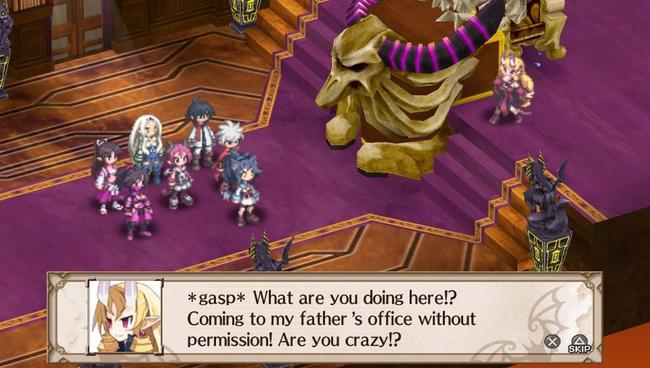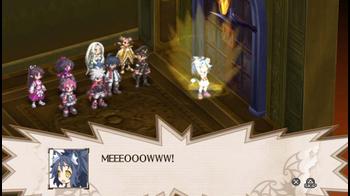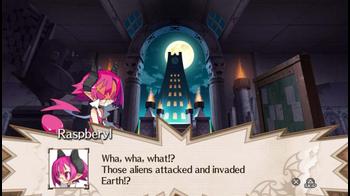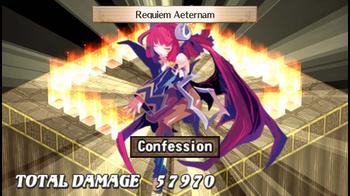
Disgaea 3: Absence of Detention Review
During its PS2 debut, the original Disgaea became one of the most definitive examples of the term "cult sensation", earning a fast and reputable fanbase for its adorable gothic Anime visuals, fourth wall sense of humor, and addictive mixture of turn based strategy and hardcore level grinding.
In a single game, Nippon Ichi Software branched out into their own independent company, creating an American branch in the process and continuing to release quirky console titles to this very day.

Never choosing to forget its roots of success, NIS continues to keep the Disgaea brand alive with numerous sequels, spin-offs, and ports. With the Playstation Vita looking to gain a new portable audience NIS has chosen to grace Sony's new system the same way they graced the Playstation 3...with Disgaea 3. Though the third game ended up being the least-played in the series, perhaps a portable recreation mixed with extra content will be enough to gain a new audience.
Despite its mechanical improvements, one of the biggest gripes about Disgaea 2 was its more serious (and ultimately more generic) storyline, including a main character who fashioned himself a hero of justice without irony (as well as being "not into girls).
Disgaea 3 tries to write back the wackiness into the series with a new demon protagonist who attends an all-demon school, determined to seek revenge on his father the Overlord for accidentally destroying the save data for his videogames. Yes, really.
Series protagonist Mao is the academy's number one honor student, which he has accomplished by never attending a single class. In the Netherworld, the more evil and mischievous your deeds, the more of a top student you become.
As a demon who claims to have the highest E.Q. (Evil Quotient, duh) of his peers, Lord Mao utilizes his Emmet Brown-style intelligence to come up with a sure-fire method for taking out his overpowered Overlord father....by stealing the title of a renowned hero.
Sure enough, Mao gets his hands on self-styled hero Almaz, stealing his hero title and turning him into his slave (which results in a gradual demonic transformation for the hapless hero).
Unsurprisingly, things go awry, resulting in several madcap adventures that only get sillier as the story unfolds, including several dealings with his childhood friend/rival Raspberyl; if skipping school and performing evil deeds makes you an honor student, than Raspberyl chooses the life of a delinquent by having perfect attendance and doing volunteer work....by Netherworld logic, this makes her a "bad-ass" in the eyes of her fellow demons.
The premise is every bit as stupid as it sounds, which is what makes Disgaea 3 a much more memorable affair than its straight-laced predecessor. Rarely does the game ever take itself seriously, instead piling on the absurd characters and situations to such dizzying heights that the inclusion of Power Rangers knock-offs and demonic penguins soon become standard affair by comparison.
This is accentuated further with the Anime-heavy art style (featuring demonic creatures both petite and top-heavy, but are all adorable) and cartoonishly appropriate voice acting (including Fullmetal Alchemist alumni Vic Mignogna as Lord Mao, delivering a mad scientist-like performance that is both sufficient yet also occasionally veers off the intended tone of the script).
If the wacky visuals and wackier storyline do nothing for you, rest assured that Disgaea 3 has more than enough gameplay content to satisfy you....provided you haven't grown tired of the series formula yet. As with the previous games, combat takes place in turn-based maps, where players must amass a selected group of demons to send out and meet the opposing side.
Each character is controlled one at a time, and must be given a command before moving on to the next follower. Once a command has been given, players can choose to execute the action on the spot or execute every action after ending their turn.
There are different strategic advantages when choosing to execute a command individually or with a group, but the biggest incentive for the former is that the longer a string of attacks lasts, the higher the resulting damage from the combo meter. Longer chains also result in filling the bonus meter, which determines the number of extra rewards gained from completing a stage (stronger weapons, more exp, etc).
But the most recognizable advantage to prudent planning lies with the team attacks, a mainstay of the Disgaea franchise; characters placed next to each other may join in on the lead character's attack (this is determined by the percentage synched between allies), resulting in a flashy combo where up to four characters at once can participate.
Best of all, a team attack only uses up the turn of the attacker, allowing allies to reform with another attacker to unleash another attack. With the right placement of demonic troops, players can initiate continuous strings of team attacks, which leads to higher damage and larger bonuses.
This is just a tiny coverage of the near-limitless amount of strategies players can take on the battlefield. It's a whole other ballgame when cubes and tiles are involved (where different colored cubes placed on colored tiles can offer helpful or hindering bonuses to whoever stands on them), which features even more puzzle-based methods for taking out foes. There's also the amusing-yet-useful strategy of having party members pick up and toss fellow friends (and foes) for both offensive and defensive purposes...or to just throw them to an otherwise inaccessible treasure chest.
Characters also possess unique special moves (including brand new job-based specials for the Vita version), but can also combine with another character's special for a Chrono Trigger-style double attack. For an even more effective combination, monster teammates can transform into weapons to be wielded by fellow allies for a few turns.
Many and more skills can be learned for every character, from story-based allies to custom-created classes, as well as Evilities (which included additional stat-boosting skills like poison resistance, additional magical spells, and so forth), and weapon skills (which are literally learned by leveling up weapons, armor and items through the Item World).
Each and every upgrade in Disgaea 3 runs on a certain form of currency; items and equipment are purchased with HL ("Hell", aka money), Evilities require Mana (skill points), and leveling up characters requires old-fashioned experience points. Despite the different requirements for each upgrade, all of them are earned the same way: through battles.
While the main storyline does not require excessive level grinding, any Disgaea veteran will tell you that the game does not truly begin until you've spent countless hours taking your characters' levels to the hundreds. For those new to the series, the game features several methods to accomplish this that are less about "exploiting the game" and more about "taking advantage of it".
The aforementioned cube system is one such method, where certain stages feature tiles that double a character's experience points, while taking low level allies to assist a teammate's frontal assault on a powerful enemy will result in shared exp for everyone.
But the most effective (and fun) method to gain those levels once again involves the Item World. For every single piece of weapon, armor, accessory or single-use item, there is a series of stages filled with enemies of varying strength. These worlds are basically random dungeons that feature all sorts of additional variables, such as AI-controlled allies, sudden ambushes by powerful opponents, secret portals, and so on. The average enemy level and number of stages varies with each item, but the rewards far exceed those gained through the main story.
For those looking to maximize their level-grinding game, the new Attend Class feature is the perfect supplement. By attending class, players can manage and/or enhance their team setups in various ways, such as assigning characters to clubs that offer specific bonuses to their members - one club offers a cheaper rate to restore its members, while another extends the throwing distance, just to name a few.
Another methoid of enhacing your team is to create additional recruits from a growing list of job classes, even larger now thanks to Vita-exclusive additions. Even the seating arrangement in class plays an important role, as teammates who sit next to each other will result in an increase in their sync rate - which increases the odds of a team attack.
But the most crucial option is the ability to call an assembly of class reps in order to request certain changes to the game itself. Such requests involve stronger or weaker enemies, more expensive or cheaper items in the shop, a bigger classroom to allow more characters to join, etc.
This mechanic gives players the freedom to customize the entire game to their preference, whether that be a more challenging experience or new ways to further gain those levels. Such requests come with a price, however (Mana), and you're not always guaranteed to get your way; each request must be voted unanimously by the AI class reps before they come to pass.
Fortunately, each rep is color-coded to indicate which way they plan to vote, and can be bribed with desired items to increase or otherwise solidify their approval. Fail to gain enough support, and your bid is rejected and the Mana lost, though you can also choose to literally beat them into submission. Considering the incredibly high levels of some reps, however, don't expect victory on a normal playthrough.
As you can see, Disgaea 3 is bursting with content, with the Vita version reaching critical levels of obesity with its inclusion of additional storylines, character cameos, and all of the DLC of the PS3 version included at no extra cost. Much of this extra content normally cannot be accessed until the main story is complete, although a handy cheat code lets impatient players gain access right from the start.
Yet all of this content ultimately revolves around the game's battle system, which is unchanged from the previous two games minus a few key refinements. If you weren't sold on the idea of dealing over a billion HP damage just for bragging rights, this enhanced portable edition may not have enough to win you back.
For series regulars, the ability to play a flawless port of the PS3 original in the palm of their hands should suffice, as well as the extra content and enhanced visuals (character portraits are now fully animated as in Disgaea 4, though it's unfortunate that they did not also bring over the upscaled HD sprites; the "smooth" graphics option is a poor and ugly substitute that should be turned off by default).
Tragically, the Vita version lacks a quicksave feature during battles, a missing feature that will be especially missed during the lengthier Item World stages. The rear touchpad controls are also more hindering than helpful, as bigger fingers may inadvertently mess with the camera angles during routine play.
It may lack a few key features in a portable release, but there is no denying the quality of Disgaea 3’s port or its limitless amount of extras. Fans will have no excuse to skip class on this one, while curious newcomers looking for a good entry point should consider enrolling on this strategy-based semester.



